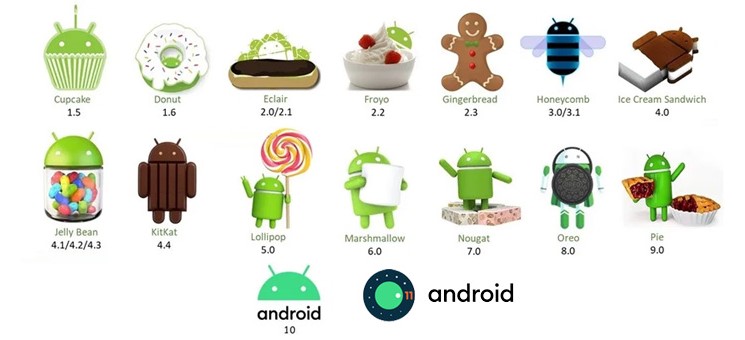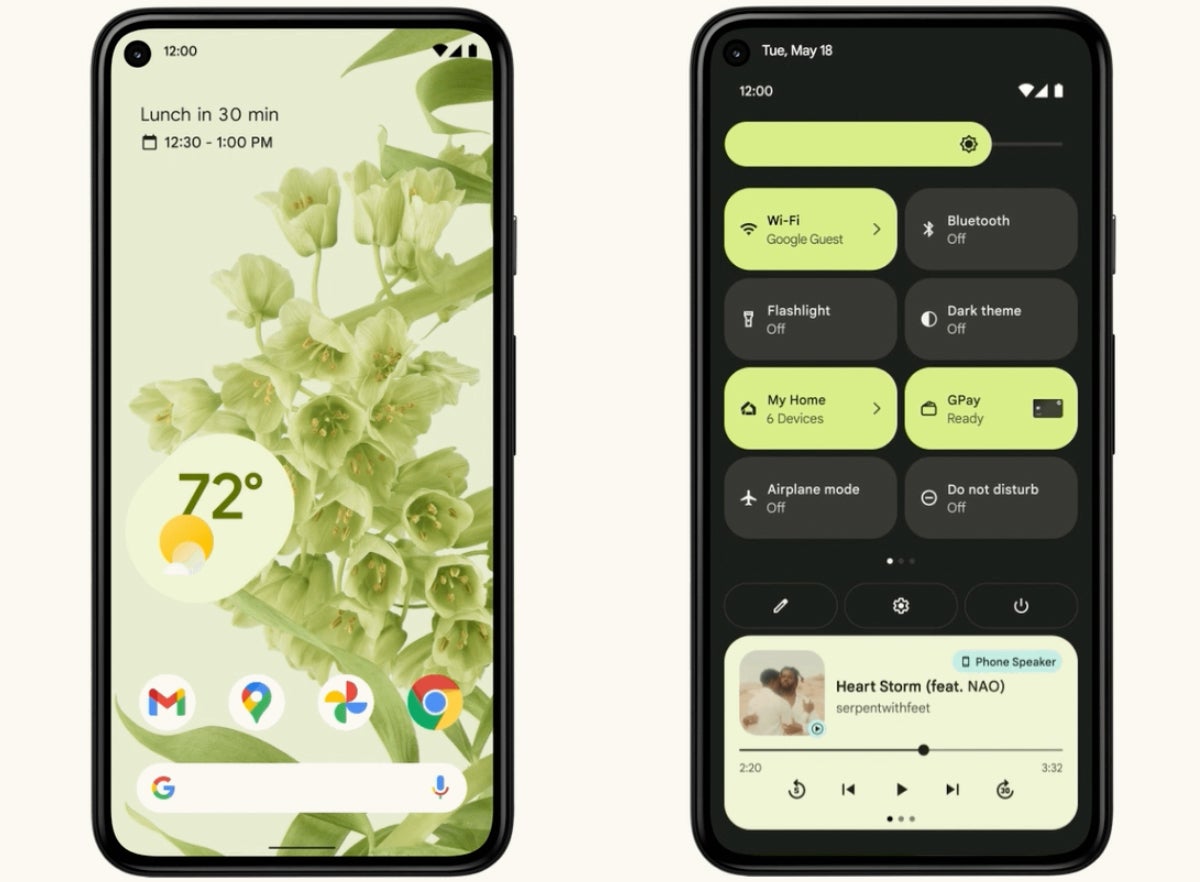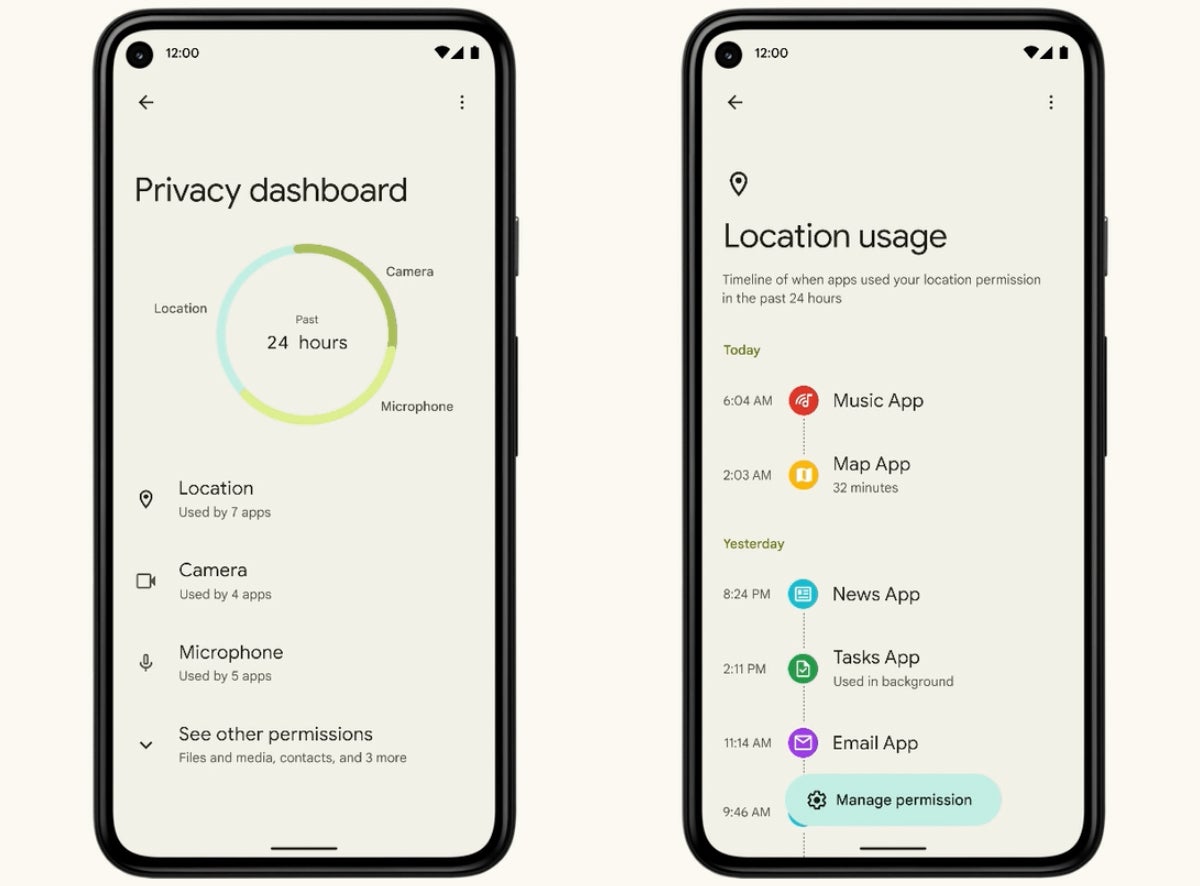This visual timeline showcases Android’s continuous evolution, starting from the time before Cupcake and spanning all the way to the release of Android 13 in 2022.
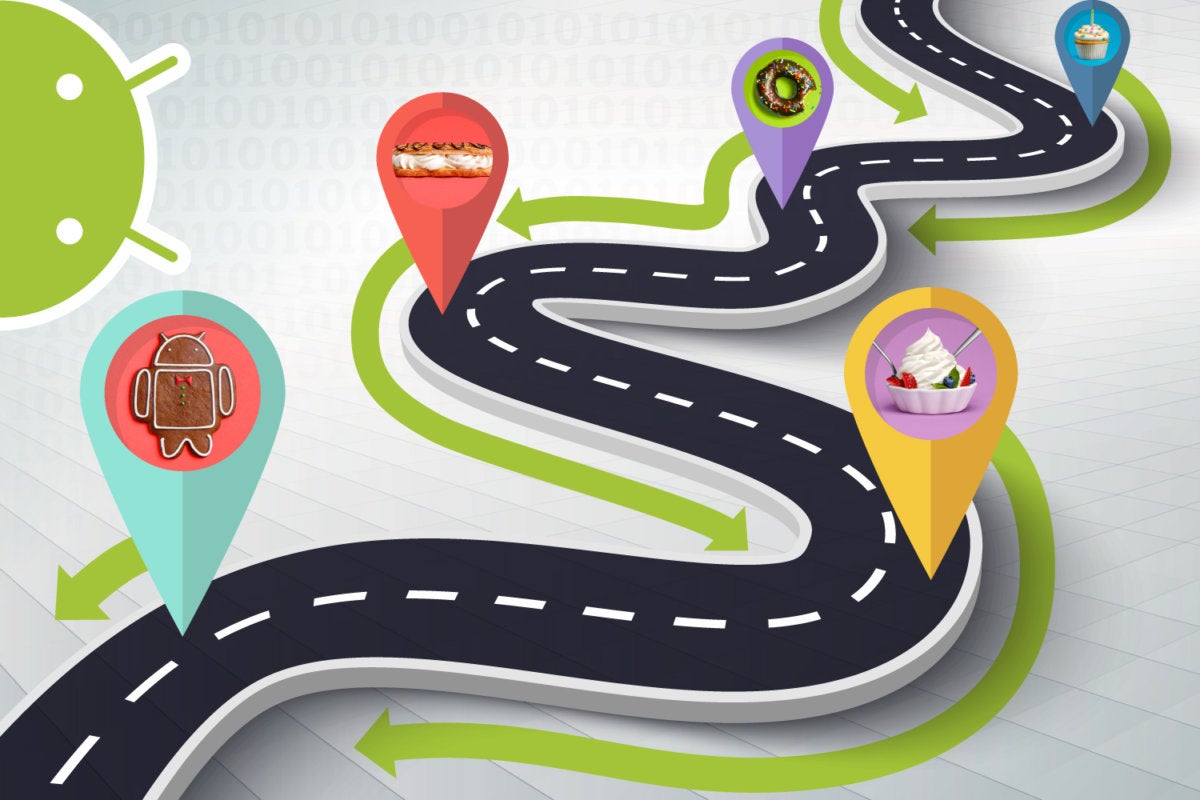
What an incredible journey it has been!
Since its initial release, Android has undergone numerous visual, conceptual, and functional transformations. Google’s mobile operating system began as an underdog, but my, oh my, has it progressed!
This is a speedy rundown of noteworthy Android version highlights, spanning from the platform’s inception to the present day. (Feel free to skip ahead if you’re solely interested in discovering the latest features in Android 12 or Android 13.)
The dawn of Android: A look at the early days of versions 1.0 to 1.1.
Android made its initial public debut in 2008 via Android 1.0, a release so archaic that it lacked a catchy codename.
In the early days, the software was relatively simplistic, but it did contain a suite of early Google apps such as Gmail, Maps, Calendar, and YouTube, all of which were integrated into the operating system. This is a notable contrast to the current easily updatable standalone-app model.
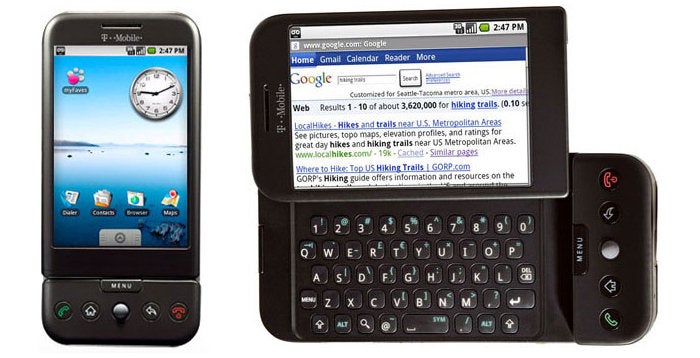
The Android 1.0 home screen and its rudimentary web browser (not yet called Chrome).
Android Version 1.5: Cupcake.
In the early months of 2009, Android 1.5 Cupcake was released, marking the inception of Android version names. Cupcake featured various enhancements to the Android interface, such as the initial on-screen keyboard — a requirement for phones transitioning away from the once-ubiquitous physical keyboard model.
Third-party app widgets were also introduced in Cupcake’s framework, rapidly becoming one of Android’s most distinct characteristics, and it presented the platform’s inaugural option for video recording.
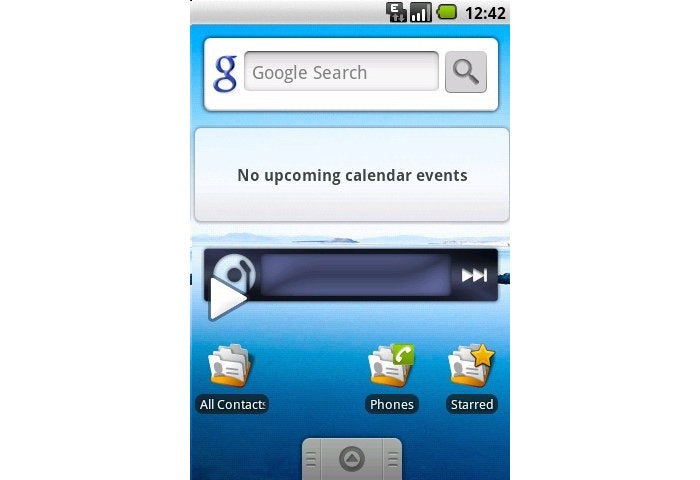
Cupcake was all about the widgets.
Android Version 1.6: Donut.
Android 1.6, Donut, made its debut in autumn of 2009. Donut addressed significant gaps in Android’s core, such as the capability to run on diverse screen sizes and resolutions — a critical aspect in the years ahead. Additionally, it provided support for CDMA networks like Verizon, which played a key role in Android’s subsequent surge.
 Google
Google
Android’s universal search box made its first appearance in Android 1.6.
Android Versions 2.0 to 2.1: Eclair.
Android 2.0, Eclair, was released just six weeks after Donut, maintaining the rapid release pattern of Android’s initial years. A couple of months later, its “point-one” update, also called Eclair, was rolled out. Eclair became the first Android version to gain widespread attention, primarily because of the original Motorola Droid phone and the extensive marketing campaign led by Verizon.
Android’s Eclair release, which included version 2.0 and 2.1, arrived shortly after Donut and made a significant impact on the mobile industry. Its standout feature was the addition of voice-guided turn-by-turn navigation and real-time traffic information, which was previously unheard of on smartphones. In addition, Eclair introduced live wallpapers, speech-to-text functionality, and pinch-to-zoom, a feature that was once exclusive to iOS and often cited as the trigger for Apple’s legal battles against Google. The release gained further recognition through Verizon’s large-scale advertising campaign for the Motorola Droid phone, which was powered by Eclair.
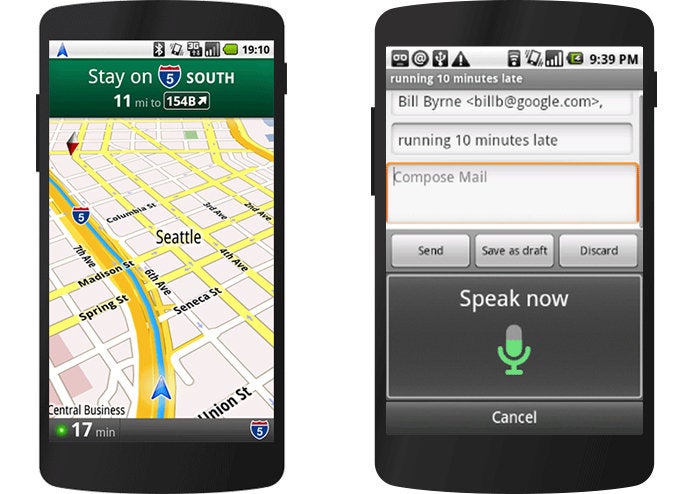 Google
Google
The first versions of turn-by-turn navigation and speech-to-text, in Eclair.
Android version 2.2: Froyo
Android 2.2, Froyo, made its debut a mere four months after Android 2.1. While the update focused primarily on behind-the-scenes performance enhancements, Froyo did introduce some noteworthy user-facing features, such as the standard dock at the bottom of the home screen and the initial version of Voice Actions. With this new feature, users could perform simple tasks such as taking notes and obtaining directions with a single tap and voice command.
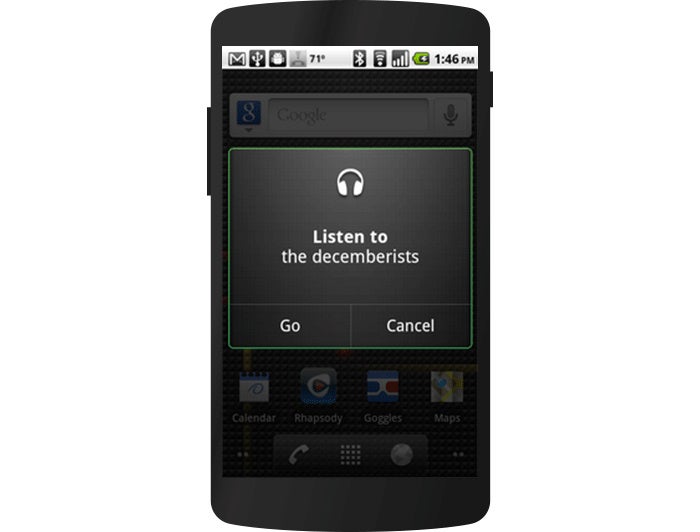 Google
Google
Google’s first real attempt at voice control, in Froyo.
Android 2.2, Froyo, also introduced support for Flash to Android’s web browser. This was a significant addition as it allowed users to access the full web without any black holes, which was not possible on Apple’s mobile devices due to their lack of support for Flash. At the time, Flash was widely used, and being able to access it on a mobile device was a genuine advantage unique to Android. However, with time, Flash became far less common and Apple’s stance against it ultimately prevailed.
Android version 2.3: Gingerbread
The year 2010 saw the advent of Gingerbread, which marked Android’s first real visual identity. The color green, which had always been associated with Android’s robot mascot, became a key element of the operating system’s look with Gingerbread. As Android gradually moved toward establishing its own unique design, the combination of black and green began to dominate the user interface.
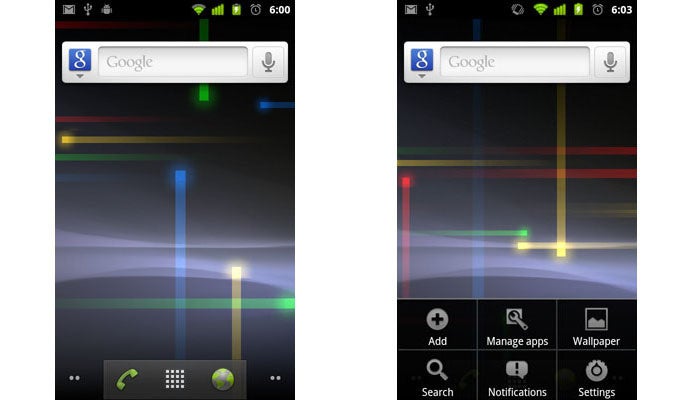 JR Raphael / IDG
JR Raphael / IDG
It was easy being green back in the Gingerbread days.
Android 3.0 to 3.2: Honeycomb
In 2011, Android experienced a strange time with its Honeycomb release. Android 3.0 was launched exclusively for tablets to accompany the debut of the Motorola Xoom. The subsequent 3.1 and 3.2 updates remained exclusive to tablets and were closed-source.
However, under the leadership of the newly appointed design chief Matias Duarte, Honeycomb brought a completely revamped UI to Android. It featured a space-themed “holographic” design that replaced the platform’s iconic green with blue and focused on optimizing the tablet’s screen real estate.
 JR Raphael / IDG
JR Raphael / IDG
Honeycomb: When Android got a case of the holographic blues.
Although Honeycomb’s tablet-specific interface didn’t persist, its impact on Android’s evolution was substantial. The release saw the introduction of on-screen buttons for Android’s primary navigation commands, which eventually replaced physical buttons, and the start of the transition away from the permanent overflow-menu button. Additionally, Honeycomb’s Recent Apps list used a card-like UI, laying the groundwork for the multitasking interface that still exists in Android today.
Android version 4.0: Ice Cream Sandwich
Ice Cream Sandwich, or Android 4.0, marked a significant shift in Android’s design philosophy towards modern and minimalistic aesthetics. It unified the user interface of Android phones and tablets with a fresh, clean look that featured a blue color scheme and more streamlined icons.
In addition to its design, Ice Cream Sandwich introduced several key features, including an updated camera app, support for facial recognition to unlock devices, a new system font called Roboto, and a data usage monitor to help users track their data consumption. It also improved text input with better autocorrect and word suggestion, and introduced Android Beam for NFC-based device-to-device sharing.
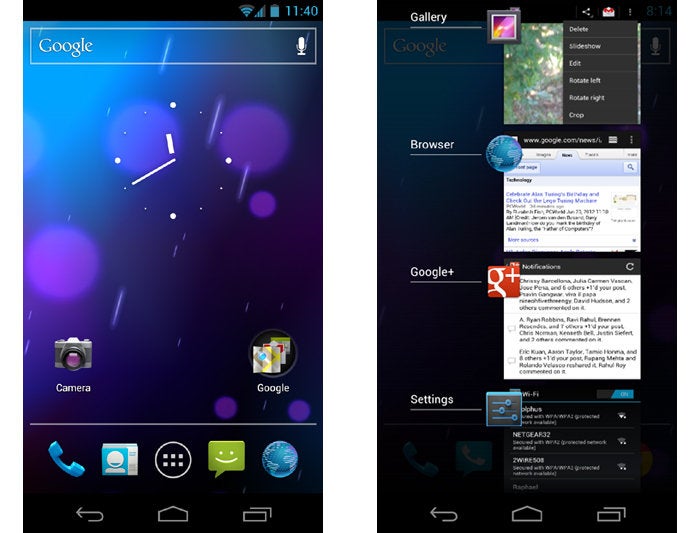 JR Raphael / IDG
JR Raphael / IDG
The ICS home screen and app-switching interface.
Android versions 4.1 to 4.3: Jelly Bean
The Jelly Bean releases of 2012 and 2013 were spread across three Android versions and marked a significant step forward in fine-tuning and enhancing the platform. The releases not only improved the operating system’s appearance but also made Android more user-friendly.
Jelly Bean introduced the revolutionary predictive-intelligence tool, Google Now, which sadly has since been reduced to a mere news feed. Additionally, the releases provided expandable and interactive notifications, an improved voice search system, and a more advanced search results system. This system focused on card-based results that tried to directly answer users’ queries.
Although multiuser support was only available on tablets at the time, Jelly Bean introduced it. The first version of the Quick Settings panel was also added to Android. Furthermore, Jelly Bean boasted a highly anticipated feature that allowed widgets to be placed on the lock screen. However, like many Android features, it quietly disappeared a few years later.
 JR Raphael / IDG
JR Raphael / IDG
Jelly Bean’s Quick Settings panel and short-lived lock screen widget feature.
Android version 4.4: KitKat
In late 2013, the release of KitKat marked the end of Android’s dark era. The operating system finally moved away from the blacks of Gingerbread and the blues of Honeycomb, replacing them with lighter backgrounds and more neutral highlights. A transparent status bar and white icons gave the OS a more contemporary look.
In addition to its visual overhaul, Android 4.4 introduced the first version of “OK, Google” support. However, the hands-free activation prompt only worked when the screen was already on and the user was either at the home screen or inside the Google app.
KitKat also marked Google’s first attempt to claim a full panel of the home screen for its services. This was only available for users of its own Nexus phones and those who downloaded its first-ever standalone launcher.
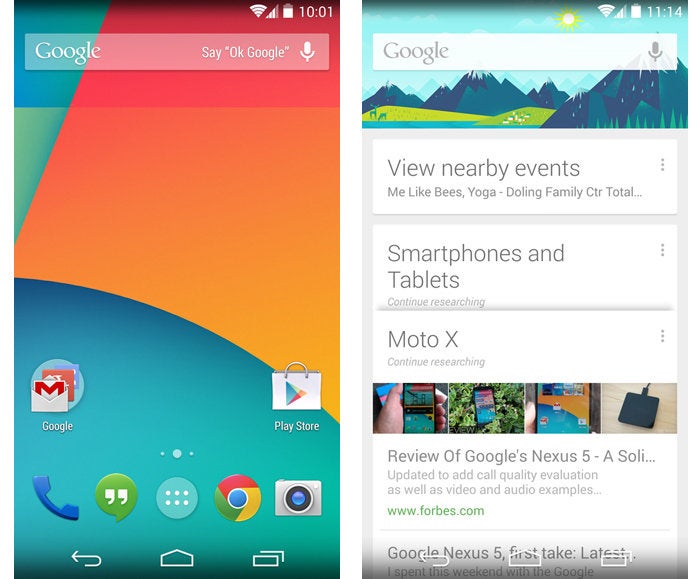
Android versions 5.0 and 5.1: Lollipop
In the fall of 2014, Google essentially reinvented Android once again with its Android 5.0 Lollipop release. This launch introduced the still-present Material Design standard, which brought a completely new look that extended across all of Android, its apps, and even other Google products.
Material Design’s card-based concept, which had been scattered throughout Android, became a core UI pattern, guiding the appearance of everything from notifications, which now appeared on the lock screen for at-a-glance access, to the Recent Apps list, which took on an unabashedly card-based appearance.
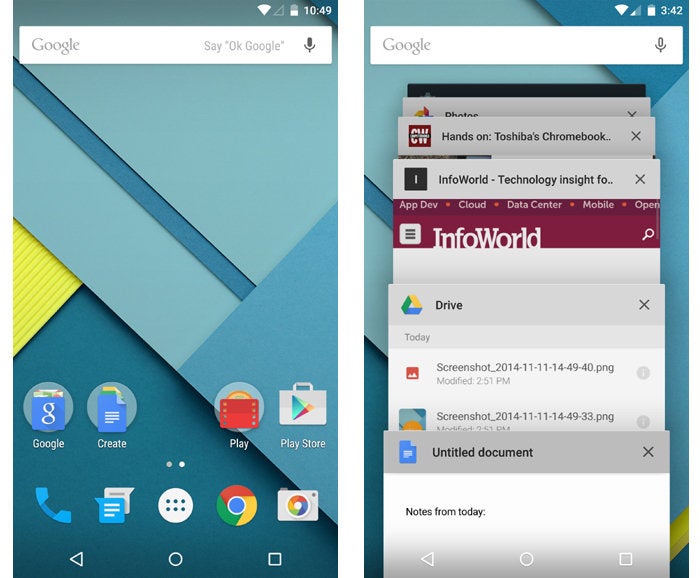 JR Raphael / IDGLollipop and the onset of Material Design.
JR Raphael / IDGLollipop and the onset of Material Design.
Lollipop also brought a bunch of new features to Android, such as hands-free voice control via the “OK, Google” command, support for multiple users on phones, and a priority mode to manage notifications more effectively. However, the update caused several issues, and many bugs wouldn’t be fixed until the next year’s 5.1 release.
Android version 6.0: Marshmallow
The year 2015 saw the release of Android 6.0 Marshmallow, which, in comparison to its predecessor, was a relatively minor update. However, it set the stage for Google’s annual Android version releases and established the pattern of each version receiving a whole number.
The highlight of Marshmallow was a feature called Now On Tap, which allowed users to search their screens by holding down the Home button. Despite its potential, the feature never quite took off and was eventually quietly phased out by Google.
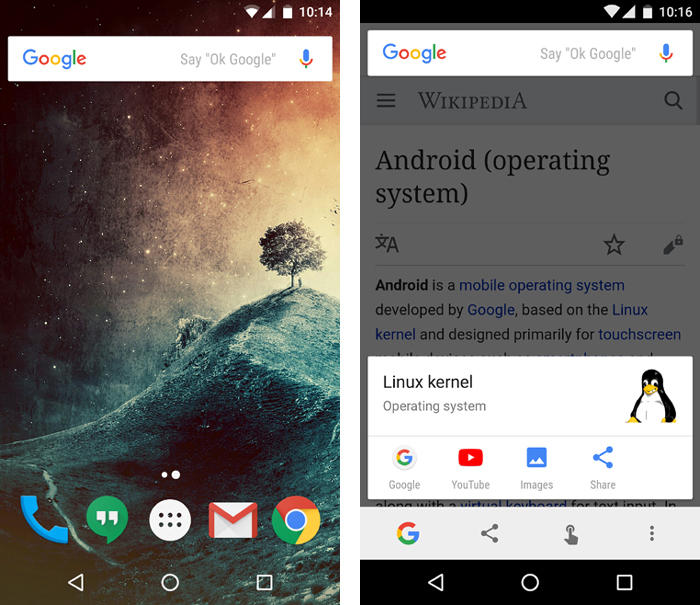
Marshmallow and the almost-brilliance of Google Now on Tap.
While Marshmallow may have seemed like a minor release, it did bring some features that have had a lasting impact on Android. One such feature was the ability to grant app permissions on a more granular level, giving users more control over their privacy. Marshmallow also added support for fingerprint readers, which have become increasingly common on Android devices. Additionally, the release introduced support for USB-C, a versatile and reversible connector that has since become the standard for many modern devices.
Android versions 7.0 and 7.1: Nougat
In 2016, Google’s Android Nougat updates brought a native split-screen mode, a new notification system organized by app, and a Data Saver feature to Android. In addition, Nougat included several smaller yet significant features, such as a shortcut for switching between apps similar to Alt-Tab.
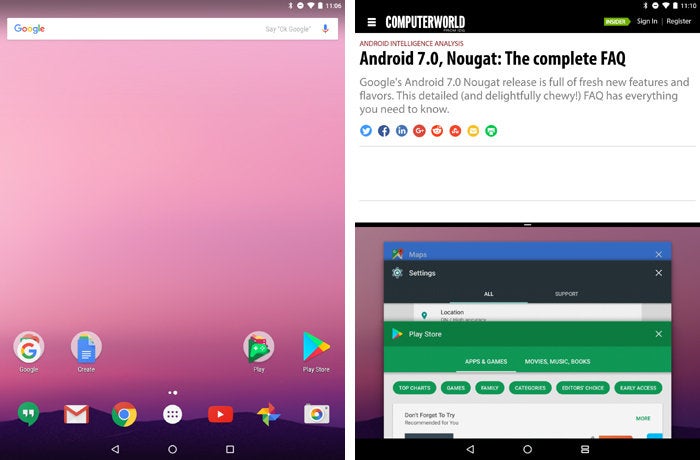 JR Raphael / IDG
JR Raphael / IDGAndroid 7.0 Nougat and its new native split-screen mode.
Nougat’s most pivotal improvement was the introduction of the Google Assistant, which coincided with the reveal of Google’s first fully self-manufactured phone, the Pixel, about two months after Nougat’s launch. The Assistant has since become a crucial element of Android and most other Google products, and is arguably the company’s primary focus today.
Android version 8.0 and 8.1: Oreo
Android Oreo, which was released in 2017, brought several improvements to the platform, including a built-in picture-in-picture mode, a notification snooze option, and notification channels that enable users to have greater control over how apps send notifications.
 JR Raphael / IDG
JR Raphael / IDG
Oreo added several significant features to the operating system, including a new picture-in-picture mode.
In 2017, Android Oreo introduced several features that aimed to better integrate Android and Chrome OS and improve the usability of Android apps on Chromebooks. Additionally, the release marked the debut of Project Treble, an ambitious initiative aimed at developing a modular foundation for Android’s code, with the goal of simplifying the process of providing timely software updates for device manufacturers.
Android version 9: Pie
In August 2018, Android Pie (or Android 9) was released, bringing with it a significant change to the navigation system. The traditional Back, Home, and Overview buttons were replaced by a large, multifunctional Home button and a small Back button that would appear as necessary, creating a hybrid gesture/button system. This change was the most notable transformation in Android Pie.
 JR Raphael/IDG
JR Raphael/IDG
Android 9 introduced a short-lived setup for getting around phones with a mix of both gestures and buttons.
Android Pie brought significant productivity features to the operating system. Among them was a universal suggested-reply system for messaging notifications, a new dashboard of Digital Wellbeing controls, and more intelligent systems for power and screen brightness management. Additionally, there were many smaller but still notable advancements in the update, such as a smarter way to handle Wi-Fi hotspots, an improved Battery Saver mode, and various privacy and security enhancements.
Android version 10
In September of 2019, Google launched Android 10, which was the first Android version to be identified solely by a number, rather than a dessert-themed name. One of the most significant changes in the software was the new interface for Android gestures, which eliminated the tappable Back button and introduced a completely swipe-based method for navigating the system.
Besides the noticeable gesture overhaul, Android 10 included various subtle yet crucial improvements. These improvements consisted of a more refined permissions system with better control over location data, a system-wide dark theme, a Focus Mode that limits distractions, and an on-demand live captioning feature for all media playing on the device.
 JR Raphael/IDG
JR Raphael/IDG
Android 10’s new privacy permissions model added some much-needed nuance into the realm of location data.
Android version 11
In September 2020, Android 11 was released, bringing substantial updates to both the surface and under the hood of the operating system.
The update focused heavily on privacy, building upon Android 10’s expanded permissions system to allow for limited, single-use grants of location, camera, and microphone permissions. It also made it more difficult for apps to detect your location in the background and automatically revokes permissions from inactive apps.
On the interface side, Android 11 introduced a refined approach to notifications related to conversations, a new streamlined media player, and a Notification History section. It also included a native screen-recording feature and a system-level menu of connected-device controls.
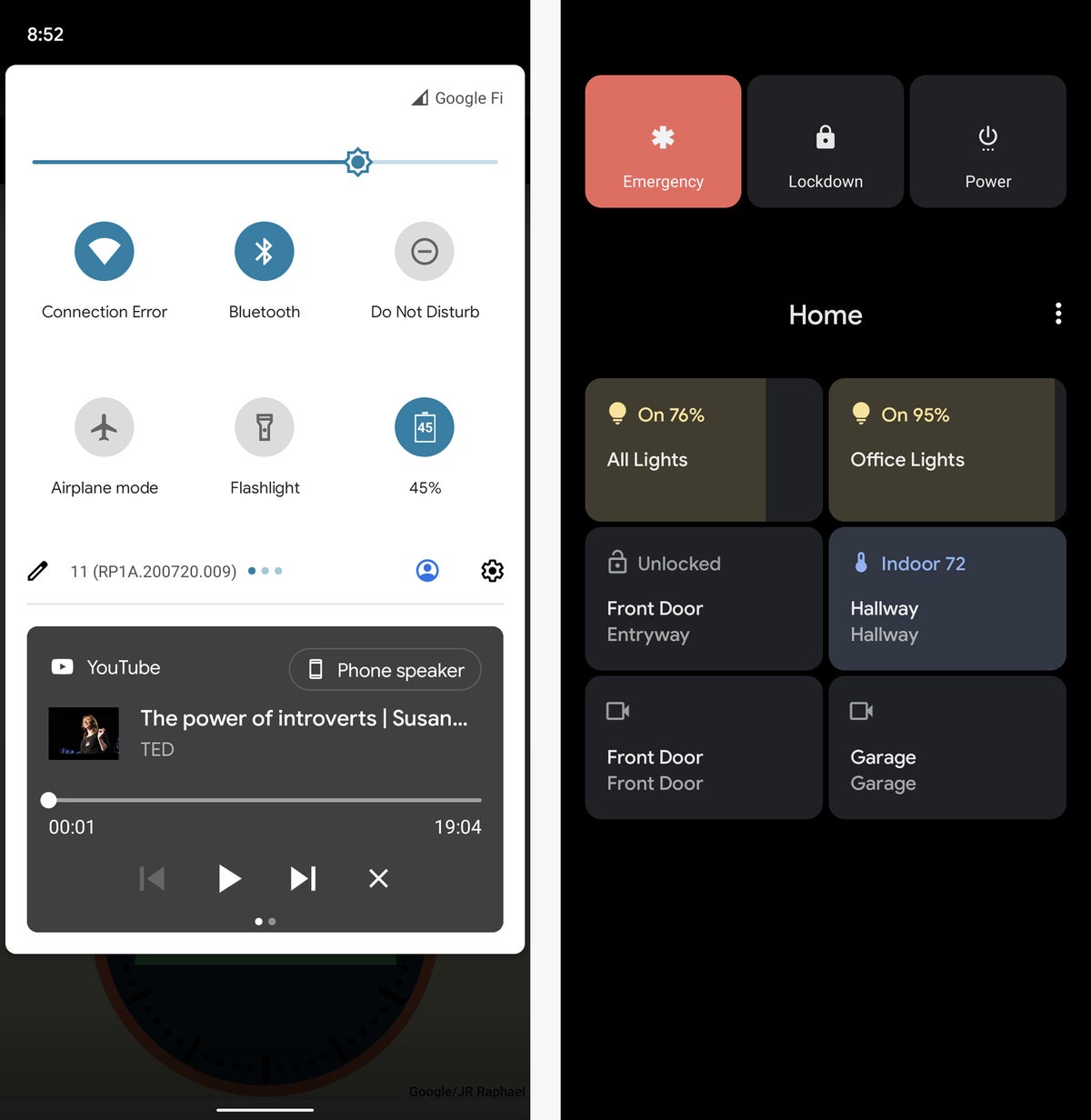 JR Raphael/IDG
JR Raphael/IDG
Android 11’s new media player brought audio controls into the Quick Settings panel, while the new connected-device controls appeared within the system-level power menu.
Android version 12
Google rolled out Android 12’s final version in October 2021 and immediately started making it available to its own Pixel devices, together with the launch of Pixel 6 and Pixel 6 Pro smartphones.
The most significant advancements with Android 12 are mainly visible, a departure from the last several Android versions. It features the most extensive redesign of Android’s interface since 2014’s Android 5.0 (Lollipop), which first introduced Google’s Material Design standard. This version includes a refreshed and entirely overhauled take on that standard, known as Material You.
Material You introduces a significantly different look and feel to the entire Android experience, extending beyond just system-level elements. The design principles will eventually extend to both your phone’s apps and Google’s web services. The same principles will appear on Chromebooks, Smart Displays, and Google-associated wearables as well. Material You allows for customization of the palette and other specifics of the interface’s appearance, with the phone generating dynamic personalized themes based on the colors of the phone’s wallpaper at any moment, making the changes deeply visible.
https://youtu.be/UHQPdP8qgrk
It is worth noting that the majority of Material You’s significant design improvements are expected to be initially available exclusively on Google’s Pixel phones. For years, third-party device manufacturers have introduced a variety of random changes to the Android interface just for the sake of it, but Google appears to have finally accepted that its Android design choices will not be universal. By doing so, Google has transformed the limited availability of the interface and its associated features into a Pixel advantage rather than a liability.
Android 12 ushers in a whole new look and feel for the operating system — at least, as it’s experienced on Google’s own devices.
Ignoring its surface-level features, Android 12 introduces improvements to Android’s widget system, as well as significant foundational upgrades to performance, security, and privacy. For example, the update offers more robust controls to manage app permissions and data usage, and it also includes a new isolated system section where A.I. features can run entirely on a device without any risk of network access or data exposure.
Android 12’s new Privacy Dashboard provides simpler and more granular details and controls over how apps are accessing your data.
Another major Android version is already being developed and released, even as Android 12 is still being rolled out to some devices.
Android version 13
Google’s Android 13, which was launched in August 2022, is a unique version of the Android operating system that has both ambitious and subtle changes. The nature of these changes is dependent on the type of device that the software is running on. For tablets and foldable phones, Android 13 introduces a completely new interface design that is focused on delivering an exceptional large-screen experience in both the operating system and within apps.
This renewed focus includes a set of guidelines and a fresh framework for app optimization, as well as a more capable split-screen mode for multitasking, and a taskbar similar to ChromeOS that makes it easy to access frequently used apps from anywhere.
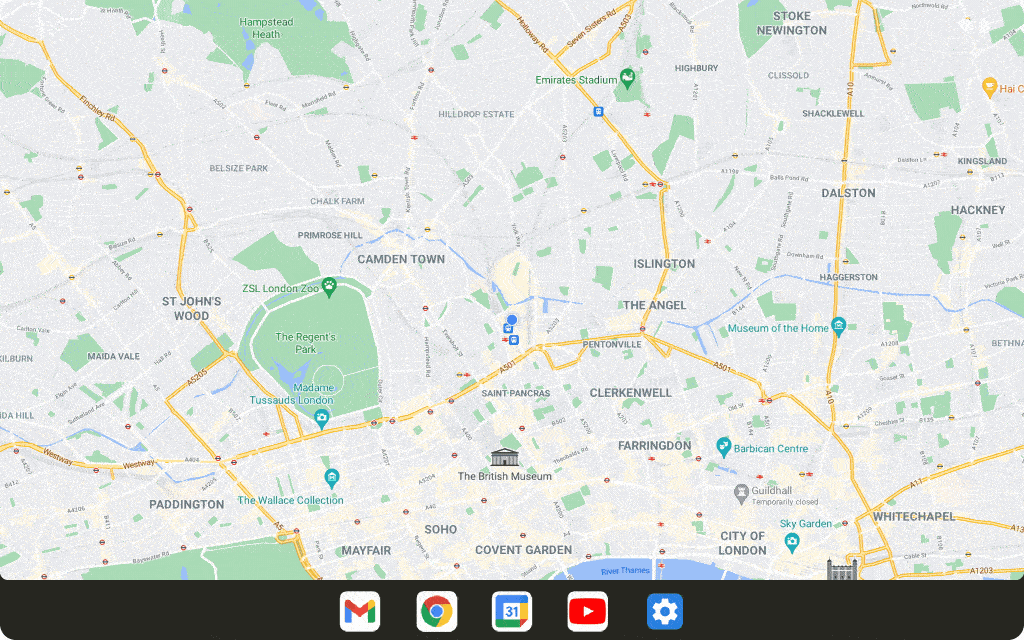
Google/JR Raphael
Android 13 introduces a more desktop-like multitasking setup for tablets and foldable phones.
Android 13, which launched in August 2022, offers a unique combination of groundbreaking features and subtle changes that depend on the device you use. For tablets and foldable phones, Android 13 comes with a revamped interface design that offers a superior large-screen experience, including a split-screen mode, taskbar, and guidelines for app optimizations. Additionally, Android 13 lays the groundwork for a new type of multipurpose device that can be used as a Smart Display or tablet, with shared-surface widgets and multiuser profile system.
However, on regular phones, Android 13 is less significant, with minor visual improvements, such as a new clipboard system, QR code scanning function, and under-the-hood enhancements for privacy, security, and performance. These changes are unlikely to be noticeable to most users.
Android 13 was released on Google’s Pixel phones in August and is expected to roll out to other non-Google devices later this year, with a slow rollout to more phones and tablets in the coming months. The upcoming Pixel Tablet may offer a glimpse into how the new features will come together.
